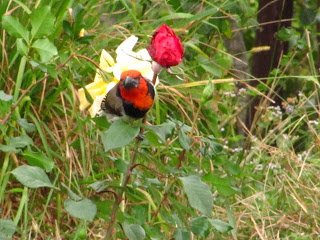It is a gregarious species and will act together when driving off intruders and roost together in nest holes, with up to 15 recorded. Their flight is direct with a loud whirring of wings.
he Black-collared Barbet has a height of 20 cms and weighs around 58 gms. The head is coloured red while the bill is coloured black. The Lybius torquatus has a red coloured throat, black legs and a brown coloured back. The eyes, head and throat are red, with the bill and legs black and the back is brown.
Black-collared Barbets are closely related to the honey guides and are members of the order Piciformes. Barbets can be small to medium sized and are similar to woodpeckers. They have short legs and paired toes that are directed forward and backwards, which is similar in their near relatives, the toucans and woodpeckers.
The name barbet comes from the French word barbu meaning bearded. Barbets are found in the tropical regions of the world, but do not live in Australia. These are stocky birds with strong colors and patterns, and they have large stout bills with obvious bristles.
There are three rose bushes in the garden of my Umngazi Valley home, in front of some Aloes and Wilde-dagga plants - all flowering at the same time. Seeing the rose buds half eaten we suspected insects but this Barbet was caught red-handed as he tore into and devoured the newly opening flowers.
The Black-collared Barbet is a monogamous bird which means that the bird finds and breeds with one partner for the rest of its life. The bird lays between 2 to 5 eggs and they are coloured white. The nest is built within a tree cavity just a few meters above the ground. The hole in the tree is normally reused in the next nesting season.
The Black-collared Barbet is mainly found in light and densely wooded forests, where there are Mopane trees. This bird eats insects such as butterflies, bees, wasps, locusts and ants. These invertebrates are usually hawked aerially, killed and then eaten. The Lybius torquatus forages mainly on the ground or at the base of trees, and low down in the shrubs eating mostly fruits and seeds. The bird also drinks nectar from flowers high up in the tree canopy.
This bird is very common in most of the Southern African Forests.

No comments:
Post a Comment